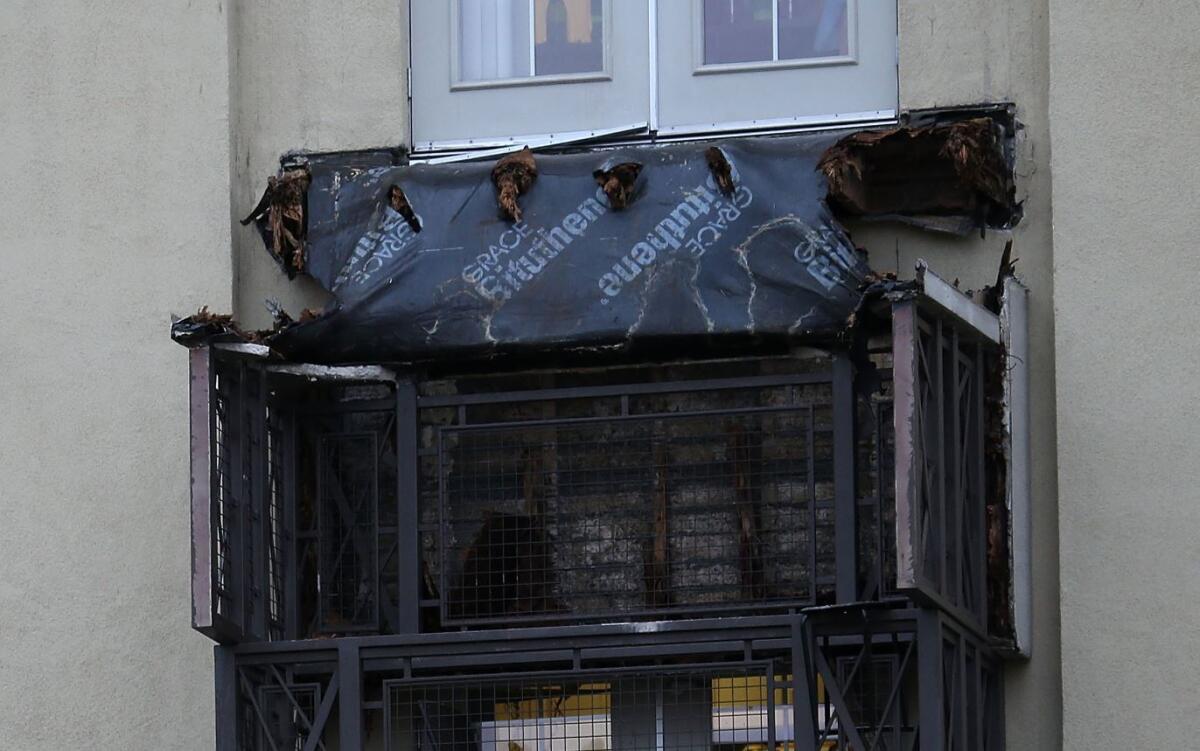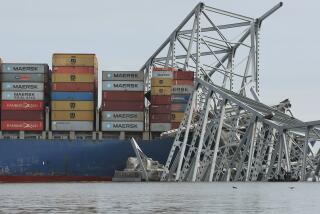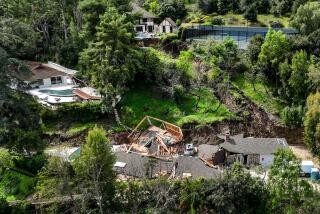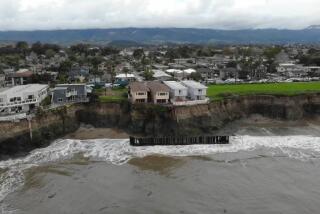Dry rot could be factor in Berkeley balcony collapse, engineers say

A section of collapsed balcony remains on the front of an apartment building in Berkeley.
Water seeping into the horizontal beams supporting a balcony could have caused dry rot, contributing to a balcony collapse that killed six people in Berkeley, engineers who visited the scene said Tuesday.
“It appears to be a classic case of dry rot, meaning water intruded into the building [and] rotted the wood” that supported the balcony, said Gene St. Onge, a civil and structural engineer in Oakland. With more than a dozen people on the balcony, “it gave way. It didn’t have enough residual strength, and it failed.”
St. Onge said the broken wooden beams protruding from the building that once held up the balcony show what looks like signs of dry rot.
“It appeared to be shredded and darkened and had all the appearance of wood that had been totally compromised by dry rot,” he said.
The balcony itself should have been able to support the weight of 13 or 14 people, he said.
“If you had 14 people, and they were all -- I don’t know -- football players, and they were jumping up and down, you would get a fair amount of deflection, depending on how well the railing was tied back,” St. Onge said. “But if the [wooden supports] were designed even under minimal standards, it should still have held.”
There are other clues that the wood had rotted. There is visible mold in one of the broken wooden joists. And it broke into short fibers at the failure point, a sign of dry rot; if the wood had not rotted, “you would see long slender splinters. It would look like a broken baseball bat,” said Bernard Cuzzillo, a consulting engineer who has a doctorate in mechanical engineering at UC Berkeley who visited the balcony scene Tuesday.
And when you look at what used to be the floor of the balcony, much of the wooden joists that once supported it have disintegrated.
Cuzzillo offered his interpretation of what happened:
The seven horizontal wooden joists that supported the balcony broke. The deck folded straight down 90 degrees, while the guardrail assembly flipped upside down.
With the deck flipped, it’s possible to see the condition of the balcony’s floor. “You will notice when you look through those things, you see a bunch of vertical lines. Those vertical lines correspond to where the joists had been attached at the bottom of the deck assembly,” he said.
“And the very startling thing is that only remnants of the joists remain in those locations,” Cuzzillo said. “You’re basically looking at what had been the joists, lined up now vertically, and now mostly gone, because they’re rotten. So basically, almost all that’s left of the joists are its shadows.”
Added Cuzzillo, “It became degraded over time due to dry rot. But then it completely disintegrated in the incident, in the fall, when it broke off.”
The wood was so deteriorated at the balcony site that when workers on the scene touched the wood, parts of it broke off, said Darrick Hom, president of the Structural Engineers Assn. of Northern California and an Oakland structural engineer for Estructure, who went to the scene Tuesday afternoon.
“It was decayed. They were touching it with their hand and pieces were coming off. Obviously, if you touch a wood beam on your deck, it should not come off in your hand,” Hom said.
Hom said as he left Tuesday afternoon workers were starting to cut open the intact balcony just below the collapsed one, possibly examining the condition of that balcony.
He agreed that had the balcony been built to the minimum code and was in good condition, the balcony should’ve been able to support 13 people. “Just the pure weight is not the deciding factor,” Hom said.
Hom said he expected investigators would look at how the balcony was designed by a structural engineer, and whether it was constructed based on the approved drawings.
He said it’s surprising to see this kind of collapse for such a new building. “To see something like this is very unexpected,” he said. It will be important to learn from this and prevent this from happening in the future, he said.
City records show the Library Gardens apartments at 2020 Kittredge Street were proposed as a mixed-use development in 2000 that was ultimately completed in 2007. The building has more than 175 rental units and 3,000 square feet of commercial space.
The owner of the land is listed as Granite Library Gardens, an investment fund managed by New York-based BlackRock. BlackRock leases the property to Greystar, a Virginia company that owns more than 400,000 residences nationwide, including Library Gardens.
Rent for one- and two-bedroom apartments at Library Gardens ranges from $2,150 a month to $4,000.
Waterproofing the supports that hold up balconies is extremely important. The wooden horizontal beams that hold them up protrude from the building. If the beams start to rot, the entire balcony can come tumbling down.
“That junction, where the [wooden] members come up beyond the exterior wall, is critically important to waterproof properly,” St. Onge said. “It appears as though that something failed there. Either the detailing wasn’t adequate, or the construction was not done properly, or something happened that allowed water to intrude.
St. Onge said it’s important to inspect apartment balconies.
“We’re seeing a lot of structures going back to the ’60s and ’70s -- they were built properly at the time – they’re starting to fail or failing completely because of age, and they’ve been neglected and not taken care of,” he said. “There have been a number of cases where decks have failed just simply because the owners haven’t been paying attention and repairing or replacing them as they should.”
City officials declined to comment at an early afternoon news briefing as to what caused the balcony to collapse. They said they are investigating.
Authorities said three of the building’s other balconies have been red-tagged, meaning people are not allowed on them. They have asked for a complete structural evaluation.
The property management company of the apartment, the Library Gardens Apartment Complex, released a statement Tuesday expressing the firm’s condolences over the tragedy.
“Our hearts go out to the families and friends of the deceased and those injured in this tragic accident. As the property management company, we have taken precautionary steps to limit access to other balconies at the apartment complex as law enforcement completes its investigation,” the statement said. “The safety of our residents is our highest priority and we will be working with an independent structural engineer and local authorities to determine the cause of the accident. We will share more details as we have them.”
BlackRock released a statement saying “we are terribly saddened by the tragic accident at Library Gardens and our hearts go out to the victims and their families. The loss of young life is truly heartbreaking and our sincerest condolences go out to all the families and communities affected by today’s terrible accident.”
BlackRock continued, saying it was in “close contact with the building’s management company and an independent structural engineer is being dispatched to conduct a thorough review of the situation.”
Lin, Serna and Rocha reported from Los Angeles; Times staff writer Javier Panzar contributed to this report from Berkeley.
Follow us on Twitter for more California breaking news: @ronlin @JosephSerna @VeronicaRochaLA @jpanzar
More to Read
Start your day right
Sign up for Essential California for news, features and recommendations from the L.A. Times and beyond in your inbox six days a week.
You may occasionally receive promotional content from the Los Angeles Times.








